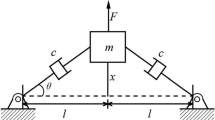Abstract
A measurement model based on torsion pendulum was established, in which nonlinear damping and nonlinear restoring force were considered. The calculation method of the moment of inertia was based on Hilbert transform. The motion of torsion pendulum showed the time-frequency characteristics due to the nonlinear factors, which were validated by the experimental data. The analytical signal was formed by Hilbert transform of the angular displacement signal of the test object. The moment of inertia can be computed by the instantaneous undamped natural frequency with Hilbert transform. Prior to the implementation of Hilbert transform, the empirical mode decomposition was used to filter the experimental signal. The moment of inertia of the test object was measured by the torsion pendulum system. The experimental results show that the relative measurement error of the moment of inertia was within 0.7%, which indicated the validity of the measurement method.
Similar content being viewed by others
References
Carsten Schedlinski, Michael Link. A survey of current inertia parameter identification methods[J]. Mechanical Systems and Signal Processing, 2001, 15(1): 189–211.
Yuan Changsheng, Song Bifeng. Theory and equipment to determine the moments of inertia by an improved compound-pendulum method[J]. China Mechanical Engineering, 2006, 17(6): 598–600 (in Chinese).
de Jong R C, Mulder J A. Accurate estimation of aircraft inertia characteristics from a single suspension experiment[ J]. Journal of Aircraft, 1987, 24(6): 362–370.
Ringegni P L, Actis M D, Patanella A J. An experimental technique for determining mass inertial properties of irregular shape bodies and mechanical assemblies[J]. Measurement, 2001, 29(1): 63–75.
Hou Zhichao, Lu Yining, Lao Yaoxin et al. A new trifilar pendulum approach to identify all inertia parameters of a rigid body or assembly[J]. Mechanism and Machine Theory, 2009, 44(6): 1270–1280.
Harris C M, Piersol A G, Paez T L. Harris’ Shock and Vibration Handbook[M]. McGraw-Hill, New York, 2009.
Li Huayi, Zhang Yingchun, Li Baohua et al. Analysis and design of the moment of inertia(MOI) measuring instrument with high accuracy[J]. Acta Metrologica Sinica, 2004, 25(3): 250–253 (in Chinese).
Matt R Jardin, Eric R Mueller. Optimized measurements of unmanned-air-vehicle mass moment of inertia with a bifilar pendulum[J]. Journal of Aircraft, 2009, 46(3): 763–775.
Tjahjowidodo T, Al-Bender F, Van Brussel H. Nonlinear modelling and identification of torsional behaviour in harmonic drives[C]. In: International Conference on Noise and Vibration Engineering. Leuven, Belgium, 2006.
Feldman M. Nonlinear free vibration identification via the Hilbert transform [J]. Journal of Sound and Vibration, 1997, 208(3): 475–489.
Zhao Yan, Zhang Xiaolin, Wang Jun et al. Measurement of the moment of inertia under nonlinear damping condition[ J]. Journal of Vibration and Shock, 2012, 31(21): 37–40 (in Chinese).
Huang N E, Wu M C, Long S R et al. A confidence limit for the empirical mode decomposition and Hilbert spectral analysis[J]. Proceedings of Royal Society of London, Series A, 2003, 459(2037): 2317–2345.
Huang N E, Shen Z, Long S R et al. The empirical mode decomposition and the Hilbert spectrum for nonlinear and non-stationary time series analysis[J]. Proceedings of Royal Society of London, Series A, 1998, 454(1971): 903–995.
Wang Lili, Zhang Jinghui, Wang Chao et al. Timefrequency analysis of nonlinear systems: The skeleton linear model and the skeleton curves[J]. Journal of Vibration and Acoustics, 2003, 125(2): 170–177.
Li Huipeng, Tang Wenyan, Zhang Chunfu et al. A measuring system of inertia moment of missile and its error analysis[ J]. Acta Armamentarii, 2007, 28(2): 206–208 (in Chinese).
Author information
Authors and Affiliations
Corresponding author
Additional information
Zhao Yan, born in 1984, male, doctorate student.
Rights and permissions
About this article
Cite this article
Zhao, Y., Zhang, X., Wang, J. et al. Measurement of moment of inertia based on hilbert transform. Trans. Tianjin Univ. 19, 225–230 (2013). https://doi.org/10.1007/s12209-013-1903-1
Accepted:
Published:
Issue Date:
DOI: https://doi.org/10.1007/s12209-013-1903-1




